Answered step by step
Verified Expert Solution
Question
1 Approved Answer
QUESTION: WRITE EXECUTIVE SUMMARY FOR CUCINA LTD PROJECT 300 WORDS MSC Applied Research Project Cucina Ltd. Competitive advantage through data integrity Company History Cucina Ltd.

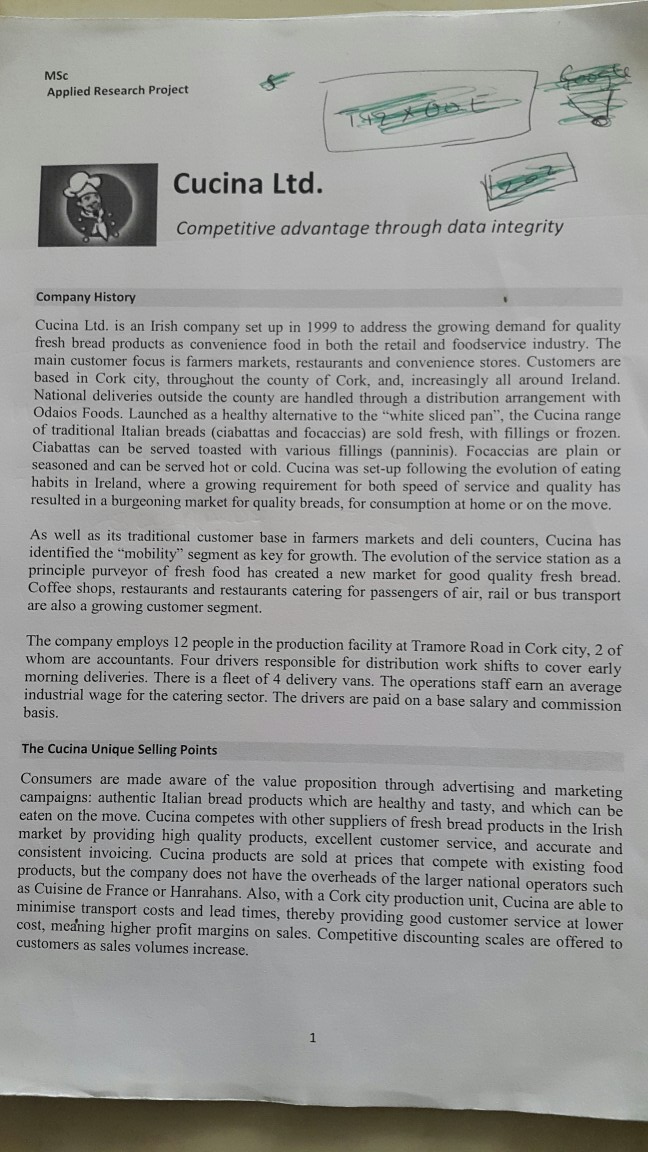
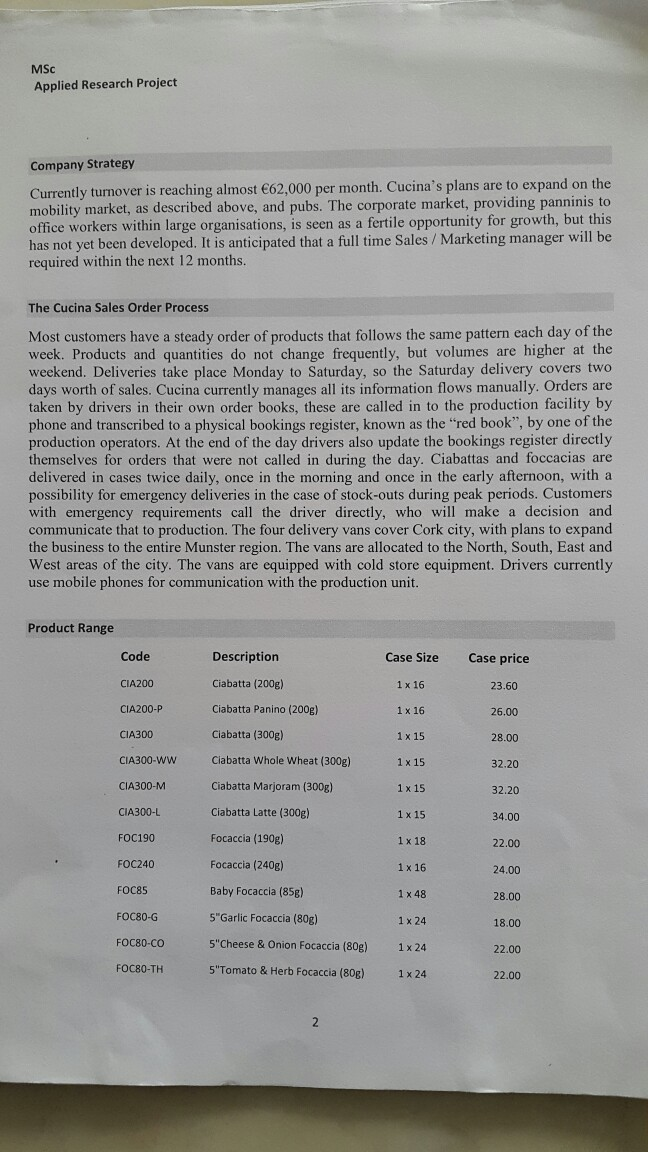
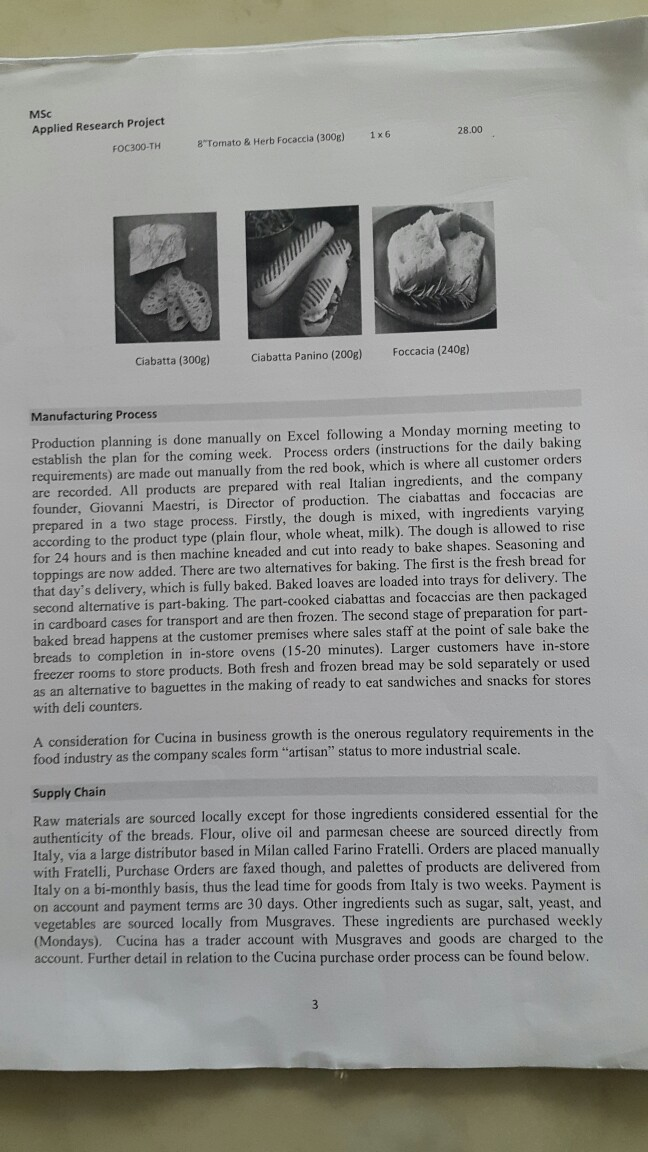
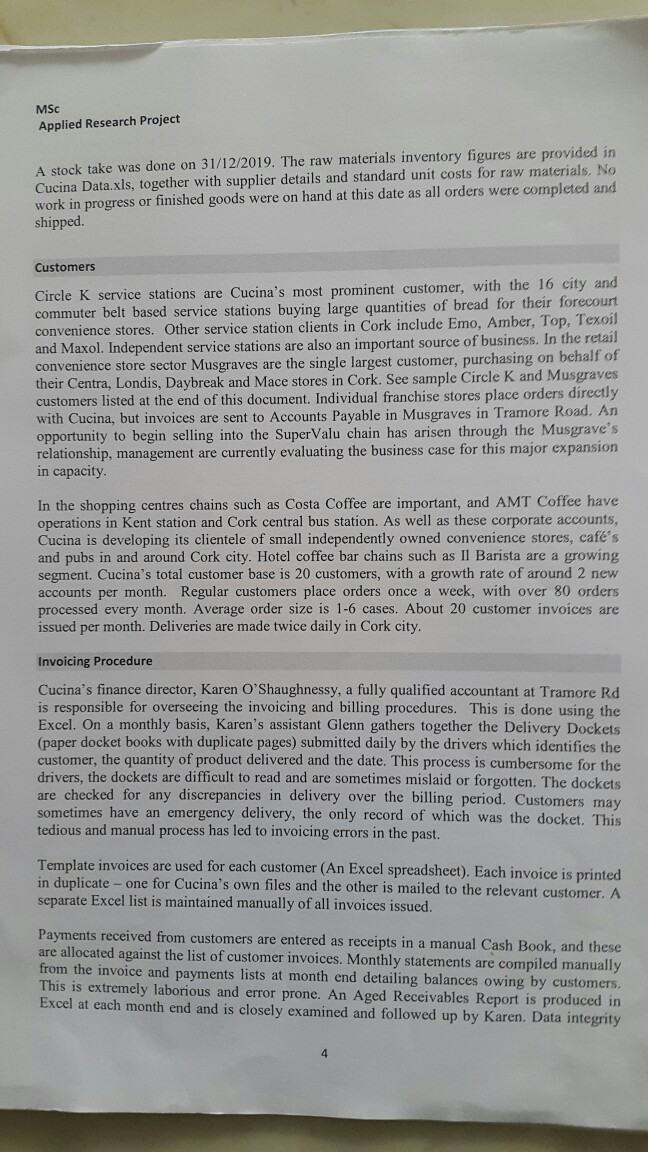
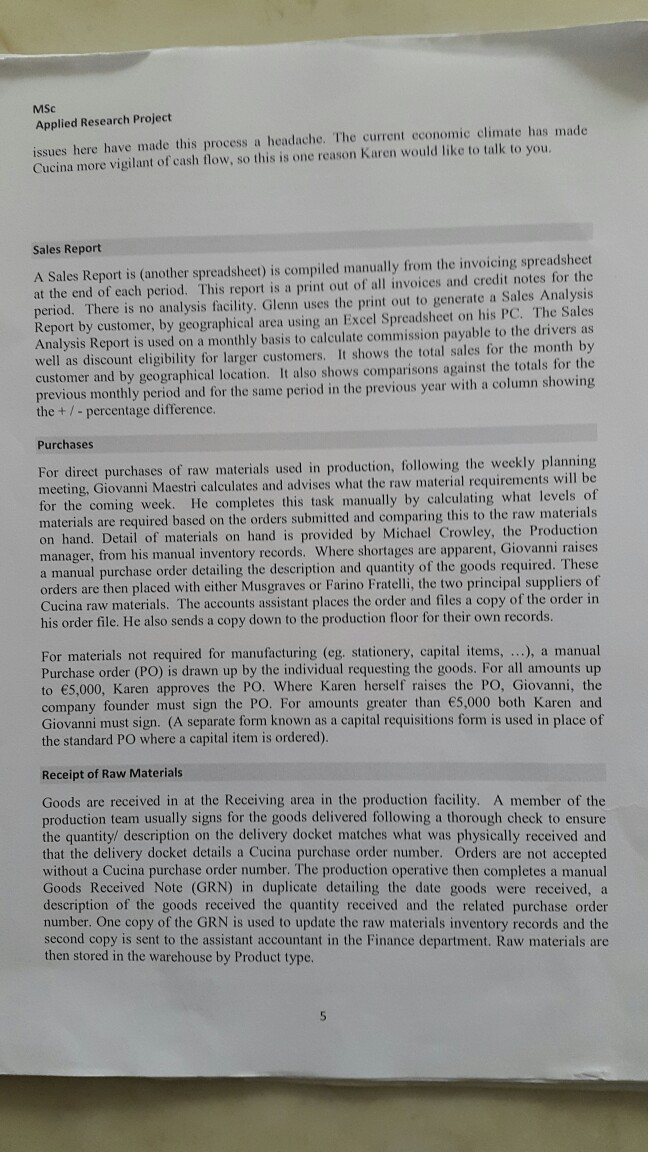
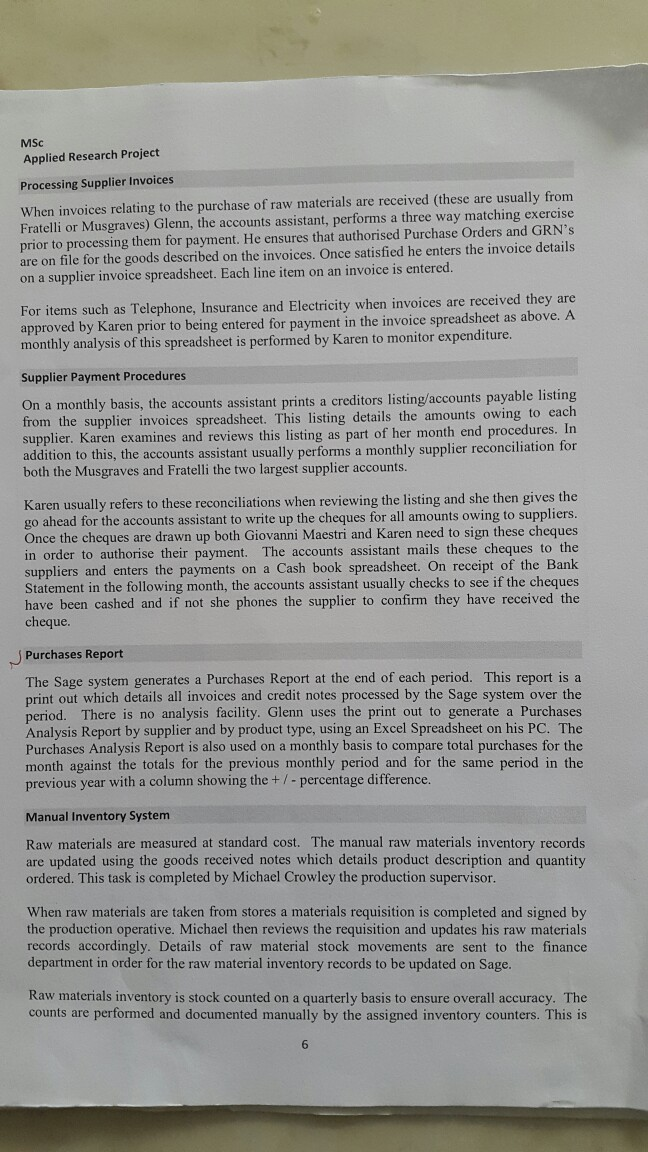
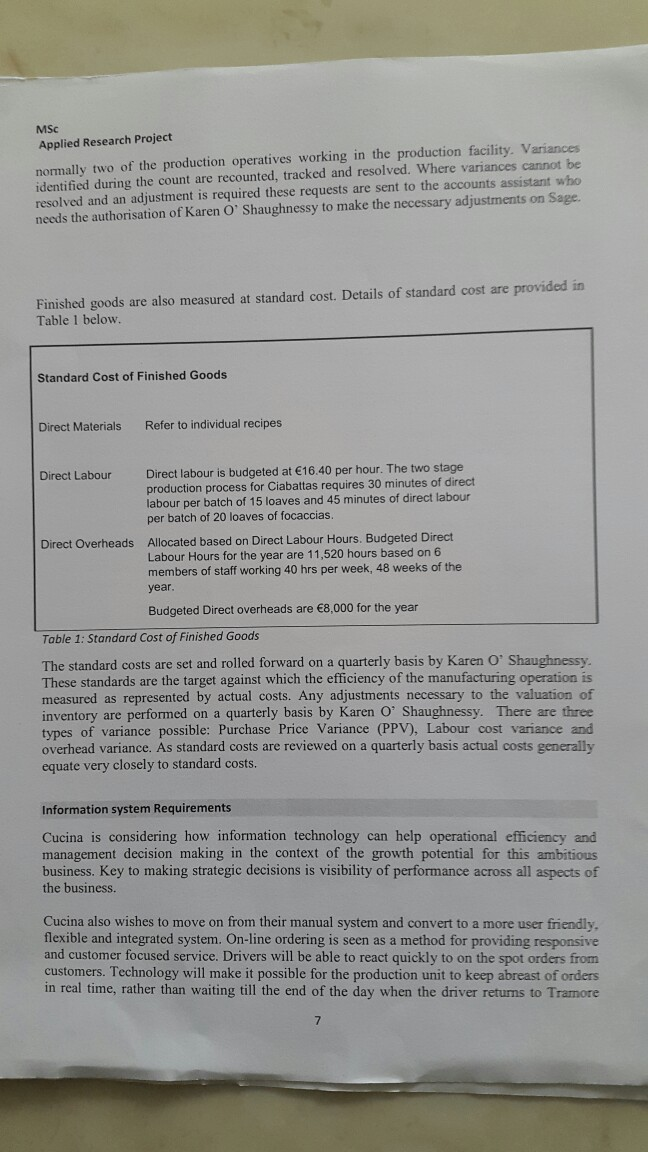
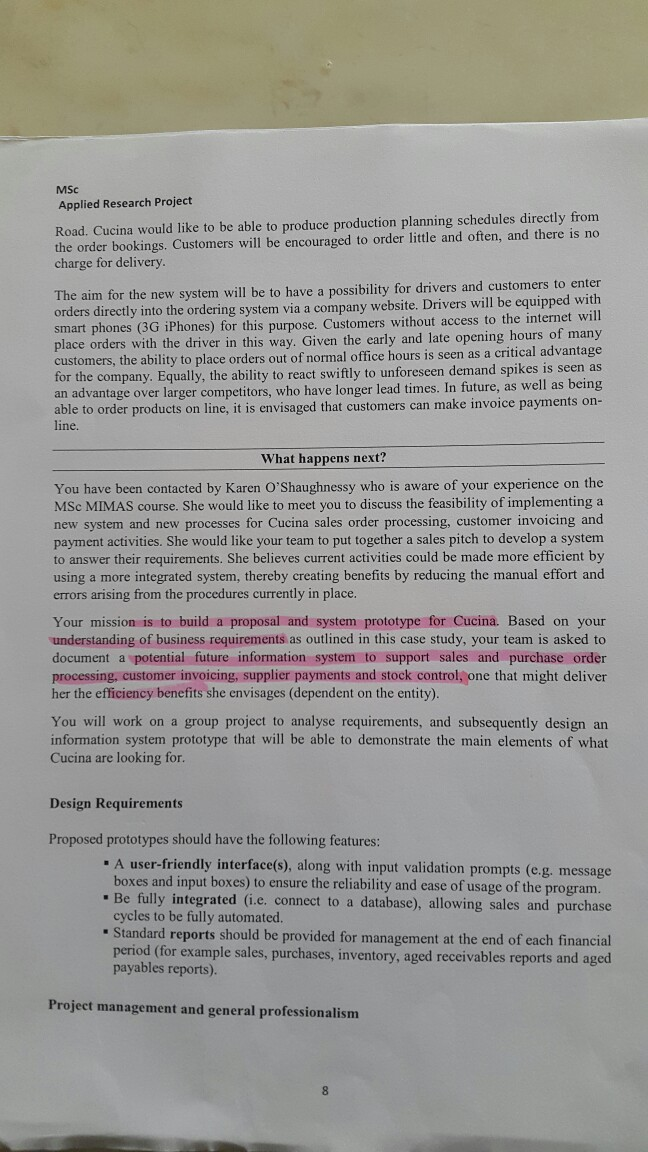
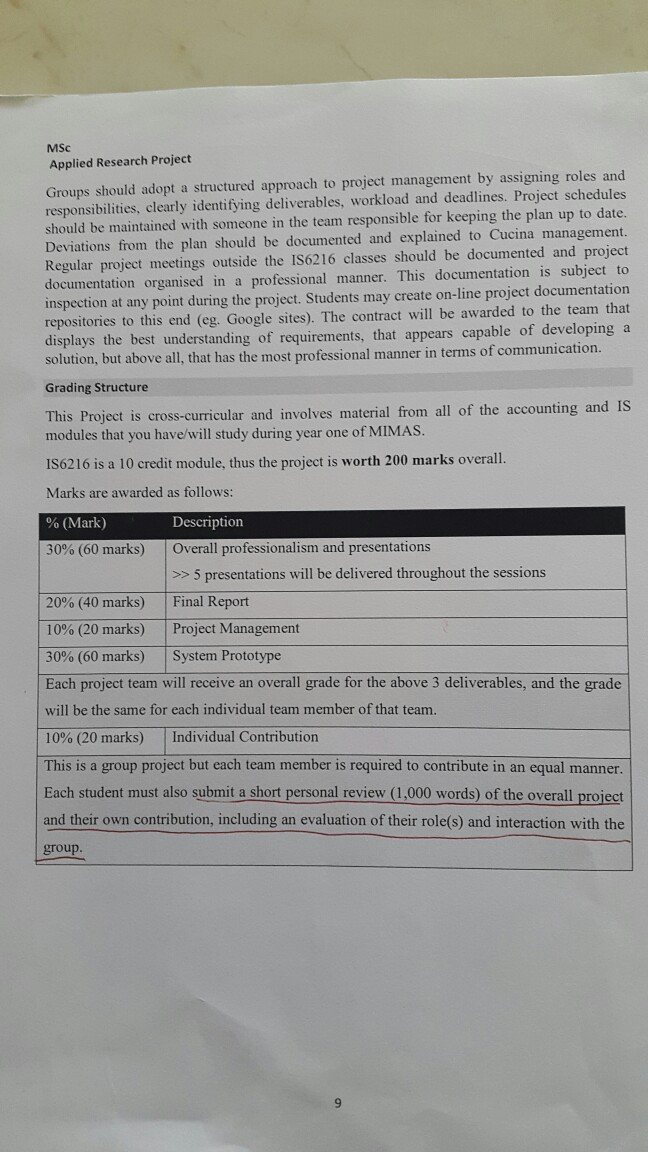
QUESTION: WRITE EXECUTIVE SUMMARY FOR CUCINA LTD PROJECT 300 WORDS MSC Applied Research Project Cucina Ltd. Competitive advantage through data integrity Company History Cucina Ltd. is an Irish company set up in 1999 to address the growing demand for quality fresh bread products as convenience food in both the retail and foodservice industry. The main customer focus is farmers markets, restaurants and convenience stores. Customers are based in Cork city, throughout the county of Cork, and, increasingly all around Ireland. National deliveries outside the county are handled through a distribution arrangement with Odaios Foods. Launched as a healthy alternative to the "white sliced pan", the Cucina range of traditional Italian breads (ciabattas and focaccias) are sold fresh, with fillings or frozen. Ciabattas can be served toasted with various fillings (panninis). Focaccias are plain or seasoned and can be served hot or cold. Cucina was set-up following the evolution of eating habits in Ireland, where a growing requirement for both speed of service and quality has resulted in a burgeoning market for quality breads, for consumption at home or on the move. As well as its traditional customer base in farmers markets and deli counters, Cucina has identified the "mobility" segment as key for growth. The evolution of the service station as a principle purveyor of fresh food has created a new market for good quality fresh bread. Coffee shops, restaurants and restaurants catering for passengers of air, rail or bus transport are also a growing customer segment. The company employs 12 people in the production facility at Tramore Road in Cork city, 2 of whom are accountants. Four drivers responsible for distribution work shifts to cover early morning deliveries. There is a fleet of 4 delivery vans. The operations staff earn an average industrial wage for the catering sector. The drivers are paid on a base salary and commission basis. The Cucina Unique Selling Points Consumers are made aware of the value proposition through advertising and marketing campaigns: authentic Italian bread products which are healthy and tasty, and which can be eaten on the move. Cucina competes with other suppliers of fresh bread products in the Irish market by providing high quality products, excellent customer service, and accurate and consistent invoicing. Cucina products are sold at prices that compete with existing food products, but the company does not have the overheads of the larger national operators such as Cuisine de France or Hanrahans. Also, with a Cork city production unit, Cucina are able to minimise transport costs and lead times, thereby providing good customer service at lower cost, meaning higher profit margins on sales. Competitive discounting scales are offered to customers as sales volumes increase. MSC Applied Research Project Company Strategy Currently turnover is reaching almost 62,000 per month. Cucina's plans are to expand on the mobility market, as described above, and pubs. The corporate market, providing panninis to office workers within large organisations, is seen as a fertile opportunity for growth, but this has not yet been developed. It is anticipated that a full time Sales/Marketing manager will be required within the next 12 months. The Cucina Sales Order Process Most customers have a steady order of products that follows the same pattern each day of the week. Products and quantities do not change frequently, but volumes are higher at the weekend. Deliveries take place Monday to Saturday, so the Saturday delivery covers two days worth of sales, Cucina currently manages all its information flows manually. Orders are taken by drivers in their own order books, these are called in to the production facility by phone and transcribed to a physical bookings register, known as the "red book", by one of the production operators. At the end of the day drivers also update the bookings register directly themselves for orders that were not called in during the day. Ciabattas and foccacias are delivered in cases twice daily, once in the morning and once in the early afternoon, with a possibility for emergency deliveries in the case of stock-outs during peak periods. Customers with emergency requirements call the driver directly, who will make a decision and communicate that to production. The four delivery vans cover Cork city, with plans to expand the business to the entire Munster region. The vans are allocated to the North, South, East and West areas of the city. The vans are equipped with cold store equipment. Drivers currently use mobile phones for communication with the production unit. Product Range Code Description Case Size CIA200 Ciabatta (200g) 1x 16 Case price 23.60 26.00 CIA200-P Ciabatta Panino (200g) 1x 16 CIA300 Ciabatta (300g) CIA300-ww 32.20 Ciabatta Whole Wheat (300g) Ciabatta Marjoram (300g) CIA300-M 32.20 CIA300-L 34.00 Ciabatta Latte (300g) Focaccia (1905) FOC190 FOC240 22.00 24.00 Focaccia (240g) FOC85 Baby Focaccia (85g) 28.00 FOC80-G 1 x 24 18.00 FOC80-CO 5"Garlic Focaccia (80g) 5"Cheese & Onion Focaccia (80g) 5"Tomato & Herb Focaccia (80g) 1x24 1x 24 FOC80-TH 22.00 22.00 MSC Applied Research Project FOC300-TH 1x6 28.00 8"Tomato & Herb Focaccia (300g) Ciabatta (300g) Ciabatta Panino (200g) Foccacia (240g) Manufacturing Process Production planning is done manually on Excel following a Monday morning meeting to establish the plan for the coming week. Process orders (instructions for the daily baking requirements) are made out manually from the red book, which is where all customer orders are recorded. All products are prepared with real Italian ingredients, and the company founder, Giovanni Maestri, is Director of production. The ciabattas and foccacias are prepared in a two stage process. Firstly, the dough is mixed, with ingredients varying according to the product type (plain flour, whole wheat, milk). The dough is allowed to rise for 24 hours and is then machine kneaded and cut into ready to bake shapes. Seasoning and toppings are now added. There are two alternatives for baking. The first is the fresh bread for that day's delivery, which is fully baked. Baked loaves are loaded into trays for delivery. The second alternative is part-baking. The part-cooked ciabattas and focaccias are then packaged in cardboard cases for transport and are then frozen. The second stage of preparation for part- baked bread happens at the customer premises where sales staff at the point of sale bake the breads to completion in in-store ovens (15-20 minutes). Larger customers have in-store freezer rooms to store products. Both fresh and frozen bread may be sold separately or used as an alternative to baguettes in the making of ready to eat sandwiches and snacks for stores with deli counters. A consideration for Cucina in business growth is the onerous regulatory requirements in the food industry as the company scales form "artisan" status to more industrial scale. Supply Chain Raw materials are sourced locally except for those ingredients considered essential for the authenticity of the breads. Flour, olive oil and parmesan cheese are sourced directly from Italy, via a large distributor based in Milan called Farino Fratelli. Orders are placed manually with Fratelli, Purchase Orders are faxed though, and palettes of products are delivered from Italy on a bi-monthly basis, thus the lead time for goods from Italy is two weeks. Payment is on account and payment terms are 30 days. Other ingredients such as sugar, salt, yeast, and vegetables are sourced locally from Musgraves. These ingredients are purchased weekly (Mondays). Cucina has a trader account with Musgraves and goods are charged to the account. Further detail in relation to the Cucina purchase order process can be found below. MSC Applied Research Project A stock take was done on 31/12/2019. The raw materials inventory figures are provided in Cucina Data.xls, together with supplier details and standard unit costs for raw materials. No work in progress or finished goods were on hand at this date as all orders were completed and shipped. Customers Circle K service stations are Cucina's most prominent customer, with the 16 city and commuter belt based service stations buying large quantities of bread for their forecourt convenience stores. Other service station clients in Cork include Emo, Amber, Top, Texoil and Maxol. Independent service stations are also an important source of business. In the retail convenience store sector Musgraves are the single largest customer, purchasing on behalf of their Centra, Londis, Daybreak and Mace stores in Cork. See sample Circle K and Musgraves customers listed at the end of this document. Individual franchise stores place orders directly with Cucina, but invoices are sent to Accounts Payable in Musgraves in Tramore Road. An opportunity to begin selling into the SuperValu chain has arisen through the Musgrave's relationship, management are currently evaluating the business case for this major expansion in capacity. In the shopping centres chains such as Costa Coffee are important, and AMT Coffee have operations in Kent station and Cork central bus station. As well as these corporate accounts, Cucina is developing its clientele of small independently owned convenience stores, caf's and pubs in and around Cork city. Hotel coffee bar chains such as Il Barista are a growing segment. Cucina's total customer base is 20 customers, with a growth rate of around 2 new accounts per month. Regular customers place orders once a week, with over 80 orders processed every month. Average order size is 1-6 cases. About 20 customer invoices are issued per month. Deliveries are made twice daily in Cork city. Invoicing Procedure Cucina's finance director, Karen O'Shaughnessy, a fully qualified accountant at Tramore Rd is responsible for overseeing the invoicing and billing procedures. This is done using the Excel, On a monthly basis, Karen's assistant Glenn gathers together the Delivery Dockets (paper docket books with duplicate pages) submitted daily by the drivers which identifies the customer, the quantity of product delivered and the date. This process is cumbersome for the drivers, the dockets are difficult to read and are sometimes mislaid or forgotten. The dockets are checked for any discrepancies in delivery over the billing period. Customers may sometimes have an emergency delivery, the only record of which was the docket. This tedious and manual process has led to invoicing errors in the past. Template invoices are used for each customer (An Excel spreadsheet). Each invoice is printed in duplicate - one for Cucina's own files and the other is mailed to the relevant customer. A separate Excel list is maintained manually of all invoices issued. Payments received from customers are entered as receipts in a manual Cash Book, and these are allocated against the list of customer invoices. Monthly statements are compiled manually from the invoice and payments lists at month end detailing balances owing by customers, This is extremely laborious and error prone. An Aged Receivables Report is produced in Excel at each month end and is closely examined and followed up by Karen. Data integrity MSC Applied Research Project issues here have made this process a headache. The current economic climate has made Cucina more vigilant of cash flow, so this is one reason Karen would like to talk to you. Sales Report at the end of each period. This report is a print out of all invoices and credit notes for the period. There is no analysis facility. Glenn uses the print out to generate a Sales Analysis Report by customer, by geographical area using an Excel Spreadsheet on his PC. The Sales Analysis Report is used on a monthly basis to calculate commission payable to the drivers as well as discount eligibility for larger customers. It shows the total sales for the month by customer and by geographical location. It also shows comparisons against the totals for the previous monthly period and for the same period in the previous year with a column showing the +/- percentage difference. Purchases For direct purchases of raw materials used in production, following the weekly planning meeting, Giovanni Maestri calculates and advises what the raw material requirements will be for the coming week. He completes this task manually by calculating what levels of materials are required based on the orders submitted and comparing this to the raw materials on hand. Detail of materials on hand is provided by Michael Crowley, the Production manager, from his manual inventory records. Where shortages are apparent, Giovanni raises a manual purchase order detailing the description and quantity of the goods required. These orders are then placed with either Musgraves or Farino Fratelli, the two principal suppliers of Cucina raw materials. The accounts assistant places the order and files a copy of the order in his order file. He also sends a copy down to the production floor for their own records. For materials not required for manufacturing (eg, stationery, capital items, ...), a manual Purchase order (PO) is drawn up by the individual requesting the goods. For all amounts up to 5.000, Karen approves the PO. Where Karen herself raises the PO, Giovanni, the company founder must sign the PO. For amounts greater than 5.000 both Karen and Giovanni must sign. (A separate form known as a capital requisitions form is used in place of the standard PO where a capital item is ordered). Receipt of Raw Materials Goods are received in at the Receiving area in the production facility. A member of the production team usually signs for the goods delivered following a thorough check to ensure the quantity/ description on the delivery docket matches what was physically received and that the delivery docket details a Cucina purchase order number. Orders are not accepted without a Cucina purchase order number. The production operative then completes a manual Goods Received Note (GRN) in duplicate detailing the date goods were received, a description of the goods received the quantity received and the related purchase order number. One copy of the GRN is used to update the raw materials inventory records and the second copy is sent to the assistant accountant in the Finance department. Raw materials are then stored in the warehouse by Product type. MSC Applied Research Project Processing Supplier invoices When invoices relating to the purchase of raw materials are received these are usually from Fratelli or Musgraves) Glenn, the accounts assistant, performs a three way matching exercise prior to processing them for payment. He ensures that authorised Purchase Orders and GRN's are on file for the goods described on the invoices. Once satisfied he enters the invoice details on a supplier invoice spreadsheet. Each line item on an invoice is entered. For items such as Telephone, Insurance and Electricity when invoices are received they are approved by Karen prior to being entered for payment in the invoice spreadsheet as above. A monthly analysis of this spreadsheet is performed by Karen to monitor expenditure. Supplier Payment Procedures On a monthly basis, the accounts assistant prints a creditors listing/accounts payable listing from the supplier invoices spreadsheet. This listing details the amounts owing to each supplier. Karen examines and reviews this listing as part of her month end procedures. In addition to this, the accounts assistant usually performs a monthly supplier reconciliation for both the Musgraves and Fratelli the two largest supplier accounts. Karen usually refers to these reconciliations when reviewing the listing and she then gives the go ahead for the accounts assistant to write up the cheques for all amounts owing to suppliers. Once the cheques are drawn up both Giovanni Maestri and Karen need to sign these cheques in order to authorise their payment. The accounts assistant mails these cheques to the suppliers and enters the payments on a Cash book spreadsheet. On receipt of the Bank Statement in the following month, the accounts assistant usually checks to see if the cheques have been cashed and if not she phones the supplier to confirm they have received the cheque. Purchases Report The Sage system generates a Purchases Report at the end of each period. This report is a print out which details all invoices and credit notes processed by the Sage system over the period. There is no analysis facility. Glenn uses the print out to generate a Purchases Analysis Report by supplier and by product type, using an Excel Spreadsheet on his PC. The Purchases Analysis Report is also used on a monthly basis to compare total purchases for the month against the totals for the previous monthly period and for the same period in the previous year with a column showing the +/- percentage difference. Manual Inventory System Raw materials are measured at standard cost. The manual raw materials inventory records are updated using the goods received notes which details product description and quantity ordered. This task is completed by Michael Crowley the production supervisor. When raw materials are taken from stores a materials requisition is completed and signed by the production operative. Michael then reviews the requisition and updates his raw materials records accordingly. Details of raw material stock movements are sent to the finance department in order for the raw material inventory records to be updated on Sage. Raw materials inventory is stock counted on a quarterly basis to ensure overall accuracy. The counts are performed and documented manually by the assigned inventory counters. This is MSC Applied Research Project normally two of the production operatives working in the production facility. Variances identified during the count are recounted, tracked and resolved. Where variances cannot be resolved and an adjustment is required these requests are sent to the accounts assistant who needs the authorisation of Karen O'Shaughnessy to make the necessary adjustments on Sage. Finished goods are also measured at standard cost. Details of standard cost are provided in Table 1 below. Standard Cost of Finished Goods Direct Materials Refer to individual recipes Direct Labour Direct labour is budgeted at 16.40 per hour. The two stage production process for Ciabattas requires 30 minutes of direct labour per batch of 15 loaves and 45 minutes of direct labour per batch of 20 loaves of focaccias. Direct Overheads Allocated based on Direct Labour Hours, Budgeted Direct Labour Hours for the year are 11,520 hours based on 6 members of staff working 40 hrs per week, 48 weeks of the year. Budgeted Direct overheads are 8,000 for the year Table 1: Standard Cost of Finished Goods The standard costs are set and rolled forward on a quarterly basis by Karen O'Shaughnessy. These standards are the target against which the efficiency of the manufacturing operation is measured as represented by actual costs. Any adjustments necessary to the valuation of inventory are performed on a quarterly basis by Karen O'Shaughnessy. There are three types of variance possible: Purchase Price Variance (PPV), Labour cost variance and overhead variance. As standard costs are reviewed on a quarterly basis actual costs generally equate very closely to standard costs. Information system Requirements Cucina is considering how information technology can help operational efficiency and management decision making in the context of the growth potential for this ambitious business. Key to making strategic decisions is visibility of performance across all aspects of the business. Cucina also wishes to move on from their manual system and convert to a more user friendly, flexible and integrated system. On-line ordering is seen as a method for providing responsive and customer focused service. Drivers will be able to react quickly to on the spot orders from customers. Technology will make it possible for the production unit to keep abreast of orders in real time, rather than waiting till the end of the day when the driver returns to Tramore MSC Applied Research Project Road. Cucina would like to be able to produce production planning schedules directly from the order bookings. Customers will be encouraged to order little and often, and there is no charge for delivery. The aim for the new system will be to have a possibility for drivers and customers to enter orders directly into the ordering system via a company website. Drivers will be equipped with smart phones (3G iPhones) for this purpose. Customers without access to the internet will place orders with the driver in this way. Given the early and late opening hours of many customers, the ability to place orders out of normal office hours is seen as a critical advantage for the company. Equally, the ability to react swiftly to unforeseen demand spikes is seen as an advantage over larger competitors, who have longer lead times. In future, as well as being able to order products on line, it is envisaged that customers can make invoice payments on- line. What happens next? You have been contacted by Karen O'Shaughnessy who is aware of your experience on the MSc MIMAS course. She would like to meet you to discuss the feasibility of implementing a new system and new processes for Cucina sales order processing, customer invoicing and payment activities. She would like your team to put together a sales pitch to develop a system to answer their requirements. She believes current activities could be made more efficient by using a more integrated system, thereby creating benefits by reducing the manual effort and errors arising from the procedures currently in place. Your mission is to build a proposal and system prototype for Cucina. Based on your understanding of business requirements as outlined in this case study, your team is asked to document a potential future information system to support sales and purchase order processing, customer invoicing, supplier payments and stock control, one that might deliver her the efficiency benefits she envisages (dependent on the entity). You will work on a group project to analyse requirements, and subsequently design an information system prototype that will be able to demonstrate the main elements of what Cucina are looking for. Design Requirements Proposed prototypes should have the following features: A user-friendly interface(s), along with input validation prompts (e.g. message boxes and input boxes) to ensure the reliability and ease of usage of the program. Be fully integrated (i.e. connect to a database), allowing sales and purchase cycles to be fully automated. Standard reports should be provided for management at the end of each financial period (for example sales, purchases, inventory, aged receivables reports and aged payables reports). Project management and general professionalism MSC Applied Research Project Groups should adopt a structured approach to project management by assigning roles and responsibilities, clearly identifying deliverables, workload and deadlines. Project schedules should be maintained with someone in the team responsible for keeping the plan up to date. Deviations from the plan should be documented and explained to Cucina management. Regular project meetings outside the IS6216 classes should be documented and project documentation organised in a professional manner. This documentation is subject to inspection at any point during the project. Students may create on-line project documentation repositories to this end (eg. Google sites). The contract will be awarded to the team that displays the best understanding of requirements, that appears capable of developing a solution, but above all, that has the most professional manner in terms of communication. Grading Structure This Project is cross-curricular and involves material from all of the accounting and IS modules that you have/will study during year one of MIMAS. 156216 is a 10 credit module, thus the project is worth 200 marks overall. Marks are awarded as follows: % (Mark) Description 30% (60 marks) Overall professionalism and presentations >> 5 presentations will be delivered throughout the sessions 20% (40 marks) Final Report 10% (20 marks) Project Management 30% (60 marks) System Prototype Each project team will receive an overall grade for the above 3 deliverables, and the grade will be the same for each individual team member of that team. 10% (20 marks) Individual Contribution This is a group project but each team member is required to contribute in an equal manner. Each student must also submit a short personal review (1,000 words) of the overall project and their own contribution, including an evaluation of their role(s) and interaction with the group. QUESTION: WRITE EXECUTIVE SUMMARY FOR CUCINA LTD PROJECT 300 WORDS MSC Applied Research Project Cucina Ltd. Competitive advantage through data integrity Company History Cucina Ltd. is an Irish company set up in 1999 to address the growing demand for quality fresh bread products as convenience food in both the retail and foodservice industry. The main customer focus is farmers markets, restaurants and convenience stores. Customers are based in Cork city, throughout the county of Cork, and, increasingly all around Ireland. National deliveries outside the county are handled through a distribution arrangement with Odaios Foods. Launched as a healthy alternative to the "white sliced pan", the Cucina range of traditional Italian breads (ciabattas and focaccias) are sold fresh, with fillings or frozen. Ciabattas can be served toasted with various fillings (panninis). Focaccias are plain or seasoned and can be served hot or cold. Cucina was set-up following the evolution of eating habits in Ireland, where a growing requirement for both speed of service and quality has resulted in a burgeoning market for quality breads, for consumption at home or on the move. As well as its traditional customer base in farmers markets and deli counters, Cucina has identified the "mobility" segment as key for growth. The evolution of the service station as a principle purveyor of fresh food has created a new market for good quality fresh bread. Coffee shops, restaurants and restaurants catering for passengers of air, rail or bus transport are also a growing customer segment. The company employs 12 people in the production facility at Tramore Road in Cork city, 2 of whom are accountants. Four drivers responsible for distribution work shifts to cover early morning deliveries. There is a fleet of 4 delivery vans. The operations staff earn an average industrial wage for the catering sector. The drivers are paid on a base salary and commission basis. The Cucina Unique Selling Points Consumers are made aware of the value proposition through advertising and marketing campaigns: authentic Italian bread products which are healthy and tasty, and which can be eaten on the move. Cucina competes with other suppliers of fresh bread products in the Irish market by providing high quality products, excellent customer service, and accurate and consistent invoicing. Cucina products are sold at prices that compete with existing food products, but the company does not have the overheads of the larger national operators such as Cuisine de France or Hanrahans. Also, with a Cork city production unit, Cucina are able to minimise transport costs and lead times, thereby providing good customer service at lower cost, meaning higher profit margins on sales. Competitive discounting scales are offered to customers as sales volumes increase. MSC Applied Research Project Company Strategy Currently turnover is reaching almost 62,000 per month. Cucina's plans are to expand on the mobility market, as described above, and pubs. The corporate market, providing panninis to office workers within large organisations, is seen as a fertile opportunity for growth, but this has not yet been developed. It is anticipated that a full time Sales/Marketing manager will be required within the next 12 months. The Cucina Sales Order Process Most customers have a steady order of products that follows the same pattern each day of the week. Products and quantities do not change frequently, but volumes are higher at the weekend. Deliveries take place Monday to Saturday, so the Saturday delivery covers two days worth of sales, Cucina currently manages all its information flows manually. Orders are taken by drivers in their own order books, these are called in to the production facility by phone and transcribed to a physical bookings register, known as the "red book", by one of the production operators. At the end of the day drivers also update the bookings register directly themselves for orders that were not called in during the day. Ciabattas and foccacias are delivered in cases twice daily, once in the morning and once in the early afternoon, with a possibility for emergency deliveries in the case of stock-outs during peak periods. Customers with emergency requirements call the driver directly, who will make a decision and communicate that to production. The four delivery vans cover Cork city, with plans to expand the business to the entire Munster region. The vans are allocated to the North, South, East and West areas of the city. The vans are equipped with cold store equipment. Drivers currently use mobile phones for communication with the production unit. Product Range Code Description Case Size CIA200 Ciabatta (200g) 1x 16 Case price 23.60 26.00 CIA200-P Ciabatta Panino (200g) 1x 16 CIA300 Ciabatta (300g) CIA300-ww 32.20 Ciabatta Whole Wheat (300g) Ciabatta Marjoram (300g) CIA300-M 32.20 CIA300-L 34.00 Ciabatta Latte (300g) Focaccia (1905) FOC190 FOC240 22.00 24.00 Focaccia (240g) FOC85 Baby Focaccia (85g) 28.00 FOC80-G 1 x 24 18.00 FOC80-CO 5"Garlic Focaccia (80g) 5"Cheese & Onion Focaccia (80g) 5"Tomato & Herb Focaccia (80g) 1x24 1x 24 FOC80-TH 22.00 22.00 MSC Applied Research Project FOC300-TH 1x6 28.00 8"Tomato & Herb Focaccia (300g) Ciabatta (300g) Ciabatta Panino (200g) Foccacia (240g) Manufacturing Process Production planning is done manually on Excel following a Monday morning meeting to establish the plan for the coming week. Process orders (instructions for the daily baking requirements) are made out manually from the red book, which is where all customer orders are recorded. All products are prepared with real Italian ingredients, and the company founder, Giovanni Maestri, is Director of production. The ciabattas and foccacias are prepared in a two stage process. Firstly, the dough is mixed, with ingredients varying according to the product type (plain flour, whole wheat, milk). The dough is allowed to rise for 24 hours and is then machine kneaded and cut into ready to bake shapes. Seasoning and toppings are now added. There are two alternatives for baking. The first is the fresh bread for that day's delivery, which is fully baked. Baked loaves are loaded into trays for delivery. The second alternative is part-baking. The part-cooked ciabattas and focaccias are then packaged in cardboard cases for transport and are then frozen. The second stage of preparation for part- baked bread happens at the customer premises where sales staff at the point of sale bake the breads to completion in in-store ovens (15-20 minutes). Larger customers have in-store freezer rooms to store products. Both fresh and frozen bread may be sold separately or used as an alternative to baguettes in the making of ready to eat sandwiches and snacks for stores with deli counters. A consideration for Cucina in business growth is the onerous regulatory requirements in the food industry as the company scales form "artisan" status to more industrial scale. Supply Chain Raw materials are sourced locally except for those ingredients considered essential for the authenticity of the breads. Flour, olive oil and parmesan cheese are sourced directly from Italy, via a large distributor based in Milan called Farino Fratelli. Orders are placed manually with Fratelli, Purchase Orders are faxed though, and palettes of products are delivered from Italy on a bi-monthly basis, thus the lead time for goods from Italy is two weeks. Payment is on account and payment terms are 30 days. Other ingredients such as sugar, salt, yeast, and vegetables are sourced locally from Musgraves. These ingredients are purchased weekly (Mondays). Cucina has a trader account with Musgraves and goods are charged to the account. Further detail in relation to the Cucina purchase order process can be found below. MSC Applied Research Project A stock take was done on 31/12/2019. The raw materials inventory figures are provided in Cucina Data.xls, together with supplier details and standard unit costs for raw materials. No work in progress or finished goods were on hand at this date as all orders were completed and shipped. Customers Circle K service stations are Cucina's most prominent customer, with the 16 city and commuter belt based service stations buying large quantities of bread for their forecourt convenience stores. Other service station clients in Cork include Emo, Amber, Top, Texoil and Maxol. Independent service stations are also an important source of business. In the retail convenience store sector Musgraves are the single largest customer, purchasing on behalf of their Centra, Londis, Daybreak and Mace stores in Cork. See sample Circle K and Musgraves customers listed at the end of this document. Individual franchise stores place orders directly with Cucina, but invoices are sent to Accounts Payable in Musgraves in Tramore Road. An opportunity to begin selling into the SuperValu chain has arisen through the Musgrave's relationship, management are currently evaluating the business case for this major expansion in capacity. In the shopping centres chains such as Costa Coffee are important, and AMT Coffee have operations in Kent station and Cork central bus station. As well as these corporate accounts, Cucina is developing its clientele of small independently owned convenience stores, caf's and pubs in and around Cork city. Hotel coffee bar chains such as Il Barista are a growing segment. Cucina's total customer base is 20 customers, with a growth rate of around 2 new accounts per month. Regular customers place orders once a week, with over 80 orders processed every month. Average order size is 1-6 cases. About 20 customer invoices are issued per month. Deliveries are made twice daily in Cork city. Invoicing Procedure Cucina's finance director, Karen O'Shaughnessy, a fully qualified accountant at Tramore Rd is responsible for overseeing the invoicing and billing procedures. This is done using the Excel, On a monthly basis, Karen's assistant Glenn gathers together the Delivery Dockets (paper docket books with duplicate pages) submitted daily by the drivers which identifies the customer, the quantity of product delivered and the date. This process is cumbersome for the drivers, the dockets are difficult to read and are sometimes mislaid or forgotten. The dockets are checked for any discrepancies in delivery over the billing period. Customers may sometimes have an emergency delivery, the only record of which was the docket. This tedious and manual process has led to invoicing errors in the past. Template invoices are used for each customer (An Excel spreadsheet). Each invoice is printed in duplicate - one for Cucina's own files and the other is mailed to the relevant customer. A separate Excel list is maintained manually of all invoices issued. Payments received from customers are entered as receipts in a manual Cash Book, and these are allocated against the list of customer invoices. Monthly statements are compiled manually from the invoice and payments lists at month end detailing balances owing by customers, This is extremely laborious and error prone. An Aged Receivables Report is produced in Excel at each month end and is closely examined and followed up by Karen. Data integrity MSC Applied Research Project issues here have made this process a headache. The current economic climate has made Cucina more vigilant of cash flow, so this is one reason Karen would like to talk to you. Sales Report at the end of each period. This report is a print out of all invoices and credit notes for the period. There is no analysis facility. Glenn uses the print out to generate a Sales Analysis Report by customer, by geographical area using an Excel Spreadsheet on his PC. The Sales Analysis Report is used on a monthly basis to calculate commission payable to the drivers as well as discount eligibility for larger customers. It shows the total sales for the month by customer and by geographical location. It also shows comparisons against the totals for the previous monthly period and for the same period in the previous year with a column showing the +/- percentage difference. Purchases For direct purchases of raw materials used in production, following the weekly planning meeting, Giovanni Maestri calculates and advises what the raw material requirements will be for the coming week. He completes this task manually by calculating what levels of materials are required based on the orders submitted and comparing this to the raw materials on hand. Detail of materials on hand is provided by Michael Crowley, the Production manager, from his manual inventory records. Where shortages are apparent, Giovanni raises a manual purchase order detailing the description and quantity of the goods required. These orders are then placed with either Musgraves or Farino Fratelli, the two principal suppliers of Cucina raw materials. The accounts assistant places the order and files a copy of the order in his order file. He also sends a copy down to the production floor for their own records. For materials not required for manufacturing (eg, stationery, capital items, ...), a manual Purchase order (PO) is drawn up by the individual requesting the goods. For all amounts up to 5.000, Karen approves the PO. Where Karen herself raises the PO, Giovanni, the company founder must sign the PO. For amounts greater than 5.000 both Karen and Giovanni must sign. (A separate form known as a capital requisitions form is used in place of the standard PO where a capital item is ordered). Receipt of Raw Materials Goods are received in at the Receiving area in the production facility. A member of the production team usually signs for the goods delivered following a thorough check to ensure the quantity/ description on the delivery docket matches what was physically received and that the delivery docket details a Cucina purchase order number. Orders are not accepted without a Cucina purchase order number. The production operative then completes a manual Goods Received Note (GRN) in duplicate detailing the date goods were received, a description of the goods received the quantity received and the related purchase order number. One copy of the GRN is used to update the raw materials inventory records and the second copy is sent to the assistant accountant in the Finance department. Raw materials are then stored in the warehouse by Product type. MSC Applied Research Project Processing Supplier invoices When invoices relating to the purchase of raw materials are received these are usually from Fratelli or Musgraves) Glenn, the accounts assistant, performs a three way matching exercise prior to processing them for payment. He ensures that authorised Purchase Orders and GRN's are on file for the goods described on the invoices. Once satisfied he enters the invoice details on a supplier invoice spreadsheet. Each line item on an invoice is entered. For items such as Telephone, Insurance and Electricity when invoices are received they are approved by Karen prior to being entered for payment in the invoice spreadsheet as above. A monthly analysis of this spreadsheet is performed by Karen to monitor expenditure. Supplier Payment Procedures On a monthly basis, the accounts assistant prints a creditors listing/accounts payable listing from the supplier invoices spreadsheet. This listing details the amounts owing to each supplier. Karen examines and reviews this listing as part of her month end procedures. In addition to this, the accounts assistant usually performs a monthly supplier reconciliation for both the Musgraves and Fratelli the two largest supplier accounts. Karen usually refers to these reconciliations when reviewing the listing and she then gives the go ahead for the accounts assistant to write up the cheques for all amounts owing to suppliers. Once the cheques are drawn up both Giovanni Maestri and Karen need to sign these cheques in order to authorise their payment. The accounts assistant mails these cheques to the suppliers and enters the payments on a Cash book spreadsheet. On receipt of the Bank Statement in the following month, the accounts assistant usually checks to see if the cheques have been cashed and if not she phones the supplier to confirm they have received the cheque. Purchases Report The Sage system generates a Purchases Report at the end of each period. This report is a print out which details all invoices and credit notes processed by the Sage system over the period. There is no analysis facility. Glenn uses the print out to generate a Purchases Analysis Report by supplier and by product type, using an Excel Spreadsheet on his PC. The Purchases Analysis Report is also used on a monthly basis to compare total purchases for the month against the totals for the previous monthly period and for the same period in the previous year with a column showing the +/- percentage difference. Manual Inventory System Raw materials are measured at standard cost. The manual raw materials inventory records are updated using the goods received notes which details product description and quantity ordered. This task is completed by Michael Crowley the production supervisor. When raw materials are taken from stores a materials requisition is completed and signed by the production operative. Michael then reviews the requisition and updates his raw materials records accordingly. Details of raw material stock movements are sent to the finance department in order for the raw material inventory records to be updated on Sage. Raw materials inventory is stock counted on a quarterly basis to ensure overall accuracy. The counts are performed and documented manually by the assigned inventory counters. This is MSC Applied Research Project normally two of the production operatives working in the production facility. Variances identified during the count are recounted, tracked and resolved. Where variances cannot be resolved and an adjustment is required these requests are sent to the accounts assistant who needs the authorisation of Karen O'Shaughnessy to make the necessary adjustments on Sage. Finished goods are also measured at standard cost. Details of standard cost are provided in Table 1 below. Standard Cost of Finished Goods Direct Materials Refer to individual recipes Direct Labour Direct labour is budgeted at 16.40 per hour. The two stage production process for Ciabattas requires 30 minutes of direct labour per batch of 15 loaves and 45 minutes of direct labour per batch of 20 loaves of focaccias. Direct Overheads Allocated based on Direct Labour Hours, Budgeted Direct Labour Hours for the year are 11,520 hours based on 6 members of staff working 40 hrs per week, 48 weeks of the year. Budgeted Direct overheads are 8,000 for the year Table 1: Standard Cost of Finished Goods The standard costs are set and rolled forward on a quarterly basis by Karen O'Shaughnessy. These standards are the target against which the efficiency of the manufacturing operation is measured as represented by actual costs. Any adjustments necessary to the valuation of inventory are performed on a quarterly basis by Karen O'Shaughnessy. There are three types of variance possible: Purchase Price Variance (PPV), Labour cost variance and overhead variance. As standard costs are reviewed on a quarterly basis actual costs generally equate very closely to standard costs. Information system Requirements Cucina is considering how information technology can help operational efficiency and management decision making in the context of the growth potential for this ambitious business. Key to making strategic decisions is visibility of performance across all aspects of the business. Cucina also wishes to move on from their manual system and convert to a more user friendly, flexible and integrated system. On-line ordering is seen as a method for providing responsive and customer focused service. Drivers will be able to react quickly to on the spot orders from customers. Technology will make it possible for the production unit to keep abreast of orders in real time, rather than waiting till the end of the day when the driver returns to Tramore MSC Applied Research Project Road. Cucina would like to be able to produce production planning schedules directly from the order bookings. Customers will be encouraged to order little and often, and there is no charge for delivery. The aim for the new system will be to have a possibility for drivers and customers to enter orders directly into the ordering system via a company website. Drivers will be equipped with smart phones (3G iPhones) for this purpose. Customers without access to the internet will place orders with the driver in this way. Given the early and late opening hours of many customers, the ability to place orders out of normal office hours is seen as a critical advantage for the company. Equally, the ability to react swiftly to unforeseen demand spikes is seen as an advantage over larger competitors, who have longer lead times. In future, as well as being able to order products on line, it is envisaged that customers can make invoice payments on- line. What happens next? You have been contacted by Karen O'Shaughnessy who is aware of your experience on the MSc MIMAS course. She would like to meet you to discuss the feasibility of implementing a new system and new processes for Cucina sales order processing, customer invoicing and payment activities. She would like your team to put together a sales pitch to develop a system to answer their requirements. She believes current activities could be made more efficient by using a more integrated system, thereby creating benefits by reducing the manual effort and errors arising from the procedures currently in place. Your mission is to build a proposal and system prototype for Cucina. Based on your understanding of business requirements as outlined in this case study, your team is asked to document a potential future information system to support sales and purchase order processing, customer invoicing, supplier payments and stock control, one that might deliver her the efficiency benefits she envisages (dependent on the entity). You will work on a group project to analyse requirements, and subsequently design an information system prototype that will be able to demonstrate the main elements of what Cucina are looking for. Design Requirements Proposed prototypes should have the following features: A user-friendly interface(s), along with input validation prompts (e.g. message boxes and input boxes) to ensure the reliability and ease of usage of the program. Be fully integrated (i.e. connect to a database), allowing sales and purchase cycles to be fully automated. Standard reports should be provided for management at the end of each financial period (for example sales, purchases, inventory, aged receivables reports and aged payables reports). Project management and general professionalism MSC Applied Research Project Groups should adopt a structured approach to project management by assigning roles and responsibilities, clearly identifying deliverables, workload and deadlines. Project schedules should be maintained with someone in the team responsible for keeping the plan up to date. Deviations from the plan should be documented and explained to Cucina management. Regular project meetings outside the IS6216 classes should be documented and project documentation organised in a professional manner. This documentation is subject to inspection at any point during the project. Students may create on-line project documentation repositories to this end (eg. Google sites). The contract will be awarded to the team that displays the best understanding of requirements, that appears capable of developing a solution, but above all, that has the most professional manner in terms of communication. Grading Structure This Project is cross-curricular and involves material from all of the accounting and IS modules that you have/will study during year one of MIMAS. 156216 is a 10 credit module, thus the project is worth 200 marks overall. Marks are awarded as follows: % (Mark) Description 30% (60 marks) Overall professionalism and presentations >> 5 presentations will be delivered throughout the sessions 20% (40 marks) Final Report 10% (20 marks) Project Management 30% (60 marks) System Prototype Each project team will receive an overall grade for the above 3 deliverables, and the grade will be the same for each individual team member of that team. 10% (20 marks) Individual Contribution This is a group project but each team member is required to contribute in an equal manner. Each student must also submit a short personal review (1,000 words) of the overall project and their own contribution, including an evaluation of their role(s) and interaction with the group
Step by Step Solution
There are 3 Steps involved in it
Step: 1

Get Instant Access to Expert-Tailored Solutions
See step-by-step solutions with expert insights and AI powered tools for academic success
Step: 2

Step: 3

Ace Your Homework with AI
Get the answers you need in no time with our AI-driven, step-by-step assistance
Get Started


